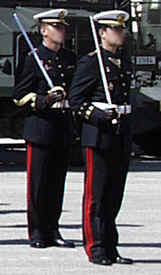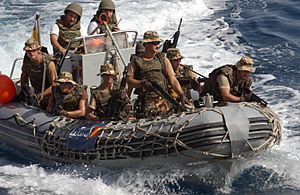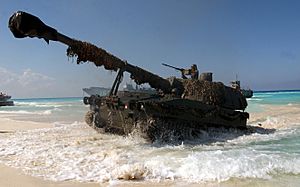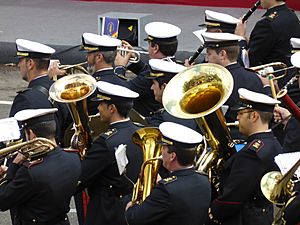Spanish Marine Infantry facts for kids
Quick facts for kids Marine Infantry |
|
|---|---|
| Infantería de Marina | |
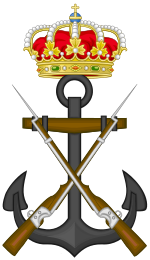
Badge of the Spanish Marine Infantry
|
|
| Founded | 27 February 1537 (488 years, 9 months) |
| Country | |
| Type | Marines |
| Role | Amphibious Warfare |
| Size | 5,700 Marines |
| Part of | Spanish Navy |
| Garrison/HQ | San Fernando, Cádiz |
| Motto(s) | "Per Terra et Mare" ("By Land and Sea!") "Brave by land and sea" ("¡Valientes por tierra y por mar!") |
| March | Marcha heroica de la Infantería de Marina |
| Anniversaries | 27 February |
| Engagements |
|
| Commanders | |
| Current commander |
Divisional General Rafael Roldán Tudela |
The Marine Infantry (Spanish: Infantería de Marina) is a special part of the Spanish Navy. These brave soldiers are known as naval infantry. Their main job is to carry out amphibious warfare. This means they can fight on land after arriving by sea.
The Spanish Marine Infantry is fully connected to the Spanish Navy. Their history goes way back to 1537. That's when Charles V, Holy Roman Emperor created the Compañías Viejas del Mar de Nápoles. This makes them the oldest marine unit still around today!
Contents
The Story of the Spanish Marines
How the Marine Infantry Began
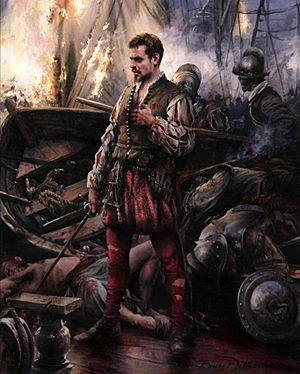
The Infantería de Armada (Navy Infantry) was started by Charles V in 1537. He assigned the Compañías Viejas del Mar de Nápoles (Old Sea Companies of Naples) to the Mediterranean Galley Squadrons.
But it was Philip II who truly shaped what a "landing force" means today. This was about using naval power to fight on land. These forces could still fight well even though they were based on ships. This time was famous for the Tercio units. A Tercio was organized with one-third musketeers, one-third swordsmen, and one-third pikemen.
Some of the first Tercios included:
- Tercio Nuevo de la Mar de Nápoles
- Tercio de la Armada del Mar Océano
- Tercio de Galeras de Sicilia
- Tercio Viejo del Mar Océano y de Infantería Napolitana
The first Tercio, the Tercio Nuevo de la Mar de Nápoles, is seen as the very beginning of the Spanish Marine Infantry. Its coat of arms had two crossed anchors. These anchors became the symbol for the entire Marine Corps until 1931.
In 1704, the Tercios changed into regiments. These included the Regimiento de Bajeles (Vessel's Regiments) and the Regimiento de la Armada (Navy Regiment). The main part of these units stayed with the Navy. They became the Cuerpo de Batallones de Marina (Navy Battalions Corps).
Marines fought in many important battles during this time:
- Algiers expedition (1541)
- Battle of Lepanto (1571)
- Conquest of the Azores (1583)
- 3rd Spanish Armada (1597)
- Recapture of Salvador (1625)
Growing and Changing: The 1700s
In 1717, the Cuerpo de Batallones de Marina was officially set up. It had 12 battalions. Their job was to be the main landing force and soldiers on ships. At this time, boarding enemy ships was still a key part of sea battles. Marines also worked as gun crews.
By the mid-1700s, there were 12,000 marine infantry and 3,000 marine gunners. The infantry formed boarding parties. The gunners operated the ship cannons. When needed, they also formed landing parties. Both groups also guarded the Navy's forts along the coast.
During the War of Spanish Independence, the marine infantry and artillery were reorganized. They often fought on land as part of army divisions. In 1793, a woman named Ana Maria de Soto joined the Navy. She pretended to be a man named Antonio Maria de Soto. She served for five years before being discovered. She was given a pension and honors when she left.
Important actions during this period included:
- Spanish conquest of Sardinia (1717)
- Spanish conquest of Oran (1732)
- Battle of Cartagena de Indias (1741)
- Siege of Havana (1762)
- Invasion of Algiers (1775)
- Siege of Pensacola (1781)
- Siege of Toulon (1793)
- Ferrol Expedition (1800)
- British invasions of the River Plate (1806)
Modernizing the Marines
After the Napoleonic Wars, naval cannons became much better. This made boarding enemy ships less common. In 1827, the marine infantry and artillery joined together. They formed the Brigada Real de Marina, focusing on artillery. This brigade was later renamed the Real Cuerpo de Artillería de Marina in 1833.
During the First Carlist War (1834-1839), three marine infantry battalions were created. They fought as regular infantry soldiers. In 1841, the infantry part was moved to the army. However, in 1848, the naval infantry was brought back. It became a new group called the Cuerpo de Infantería de Marina.
By 1869, the marines changed their main job. They went from guarding naval bases to being a landing force. They mainly served in Spain's colonies.
The marines fought in the Third Carlist War (1872–1876) as land infantry. In 1879, the marine infantry academy was founded. This was the Academia General Central de Infantería de Marina.
During the colonial wars in the Philippines and Cuba, marines were often involved in landing operations. This led to them being reorganized into three brigades. Each brigade had two regiments.
Even after Spain lost many of its colonies, the marines continued to serve abroad. Key actions in this period included:
- Spanish reconquest of Santo Domingo (1808)
- Cochinchina campaign (1858)
- Second French intervention in Mexico (1862)
- Spanish–American War (1898)
- Kert campaign (1911)
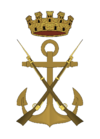
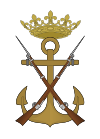
These missions were carried out by Batallones Expedicionarios (Expeditionary Battalions). Some of these battalions were on campaigns abroad for up to ten years.
Challenges and Growth: 20th Century
After World War I, many countries stopped thinking about large amphibious attacks. This was because of the difficult Battle of Gallipoli. Many marine corps faced problems, including Spain's. However, the Spanish Marine Infantry had a big success during the Third Rif War. In 1925, they carried out the Alhucemas amphibious assault. This was special because they used coordinated air and naval gunfire to support the attack.
Because of their role in the unpopular Rif Wars, the Spanish Navy Marine Corps was seen as a reminder of the Spanish colonial era. After the Second Spanish Republic was declared in 1931, there were plans to disband the corps.
But before this happened, the Spanish Civil War began. The corps split, with some marines fighting for the Nationalist side and others for the Republican side. During the war, marines performed guard duties, led landing parties, and operated artillery and machine guns.
After the civil war, during the time of Francisco Franco, the Marine Infantry grew stronger. In 1957, the Grupo Especial Anfibio (Amphibious Special Group) was created. The Spanish Marine Infantry went back to its main job as a Landing Force. In 1958, they set up a beachhead in Spanish Sahara and Ifni during the Ifni War. The Spanish Marine Infantry got new vehicles, anti-tank weapons, and artillery.
The Tercio de Armada (TEAR) became the main amphibious unit. It has changed several times to meet new needs. The Spanish Marines have served in Europe, Central America, and Asia. They act as an "emergency force" to help people in conflict areas. They also act as a strong force to prevent problems. The main base for the Spanish Marines is in San Fernando.
The Marines Today: 21st Century Missions
In the 21st century, the Spanish Marine Infantry has been part of various NATO operations, including in Afghanistan.
What the Spanish Marines Do
The Spanish Marine Infantry is an elite group. They are highly skilled in amphibious warfare. This means they can land and fight on a coast that might be dangerous. They can quickly get onto Navy ships and use Navy planes and boats. This makes them a very important unit for Spain's defense. They are also very well-trained. They can deploy quickly to distant places, making them a strong force that can prevent conflicts.
A special thing about a marine is their uniform. Spanish Marines have three "Sardinetas" on their sleeves. This shows they are part of the Royal House Corps. They earned this honor for their heroic stand at the Morro Castle during the siege of Havana in 1762. The only other unit with these "Sardinetas" and red trouser stripes is the Spanish Royal Guard.
Spanish Marines use modern equipment for their missions. They have experts in artillery, sapping (building defenses), helicopters, special operations, communications, and tanks. Some of their vehicles form the Grupo Mecanizado Anfibio del Tercio de Armada (Mechanized Amphibious Group of the Navy Tercio).
Spanish Marines are not just a fighting force. The Spanish Royal Marine Guard Company protects naval bases and facilities. They also guard naval schools and training units.
Special Operations Missions
In June 2009, a special unit called the Special Naval Warfare Force (FGNE) was created. It brought together the Special Operations Unit (UOE) of the Marine Infantry. It also included the Special Combat Divers Unit (UEBC) and the Special Explosives Defusers Unit (UEDE) from the Navy Diving Center.
This unit has taken part in several operations. These include Atalanta in Somalia, and missions in Lebanon and Haiti. They also helped in the rescue of the fishing vessel Alakrana in Somali waters.
How the Marines are Organized
The Marine Brigade
The main fighting force of the Spanish Marine Infantry is the Marine Infantry Brigade (BRIMAR). It includes several important units:
- Marine Infantry Brigade (BRIMAR)
- Headquarters Battalion: This unit handles command, signals, intelligence, and finding targets.
- 1st Landing Battalion: This battalion has a headquarters, three Naval Fusilier companies, and a weapons company.
- 2nd Landing Battalion: Similar to the 1st, with a headquarters, three Naval Fusilier companies, and a weapons company.
- 3rd Mechanized Landing Battalion: This unit has a headquarters, two mechanized companies (using Piranha IIIC 8x8 vehicles), one tank company (with M60A3 TTS tanks), and a weapons company.
- Amphibious Mobility Group: This group handles engineering, amphibious assault vehicles, anti-tank weapons, and boats.
- Artillery Landing Group: This group has different types of artillery. These include 105mm Mod. 56 field artillery and 155mm M109AE self-propelled artillery. They also have Mistral anti-air missiles.
- Combat Service Support Group: This group provides transport, medical help, supplies, and maintenance. They also help organize beach landings.
Protection Forces
The Protection Force (FUPRO) is in charge of keeping naval bases and other important places safe. It has about 2000 soldiers. FUPRO is led by a brigadier general. It is made up of several battalion-sized units called Tercios:
- Tercio del Norte (TERNOR) - Northern Regiment
- Tercio de Levante (TERLEV) - Eastern Regiment
- Tercio del Sur (TERSUR) - South Regiment
- Unidad de Seguridad del Mando Naval de Canarias (USCAN) - Canary Islands Naval Command Security Unit
- Agrupación de Infantería de Marina de Madrid (AGRUMAD) - Madrid Marine Infantry Group
Special Forces
See article: Fuerza de Guerra Naval Especial
The Fuerza de Guerra Naval Especial (FGNE) is the special operations force of the Spanish Navy. They are experts in fighting in sea, land, and coastal areas. This unit was formed by combining the Special Operations Unit (UOE) and the Special Combat Divers Unit (UEBC).
These units work together for different tasks:
- Command and control: Leading the operations.
- Combat: Direct fighting.
- Combat Support (CSU): Helping with boats and parachutes.
- Combat Services Support (CSSU): Providing health care, supplies, transport, and equipment.
Marine Company of the Royal Guard
The Compañía Mar Océano de la Guardia Real was created on December 1, 1981. It is part of the Royal Guard. It is organized like a Rifle Company.
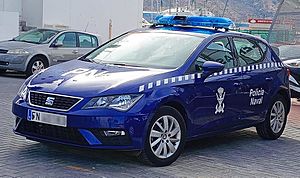
The Naval Police Units are set up to perform specific security and order missions. They watch over Navy units and facilities. They also guard and guide military transports, protect important people, and check IDs. When doing their job, they act as agents of authority.
Target Acquisition and Reconnaissance (TAR) Company
The Compañía de Reconocimiento y Adquisición de Blancos (Target Acquisition and Reconnaissance, TAR) was created in 2012. Its job is to gather information for the Marine Infantry Brigade (BRIMAR) operations. They observe and scout, find targets, and help direct artillery and air strikes. They also provide close air support and help with movement. To do this, experienced marines train in skydiving and diving techniques.
Marine Equipment

Infantry Weapons
Pistols
- Llama M82
- FN Herstal P9-17
- SIG Sauer P230 (silenced, used by Special Naval Warfare Force)
- Glock 17 Gen.5 (standard for Special Naval Warfare Force)
- Heckler & Koch USP-Compact
Assault Rifles
- Heckler & Koch G36: E, K (short barrel), and C (carbine) versions.
- Heckler & Koch HK-416A5 (used by Special Naval Warfare Force)
- CETME: Some older versions still in limited use.
Grenade Launchers
- AG36
- LAG-40M1
- Mk.19 Mod.3
Sniper Rifles
- Heckler & Koch HK417 SNIPER
- Accuracy International Arctic Warfare
- Barrett M82A1
- Barrett M95
Submachine Guns
- Heckler & Koch MP5 (A3, A4, and A5 versions)
- FN P90
Machine Guns
- FN Minimi Para (5.56×45mm NATO)
- FN Minimi MK3 (7.62×51mm NATO)
- CETME Ameli (5.56×45mm NATO, mostly replaced)
- Rheinmetall MG-3 (7.62x51mm NATO, used in vehicles or as stationary weapon)
- Browning M-2 HB QCB
Anti-tank Weapons
- Instalaza C-100 Alcotán 100mm
- Instalaza C-90C 90mm
Artillery
Guided Missiles
- TOW 2A (anti-tank)
- Spike missile (anti-tank)
- Mistral (anti-aircraft)
Vehicles
- 17 M-60A3 TTS (being replaced)
- 39 Piranha IIIC 8x8 (different types for combat, command, medical, and more)
- 19 AAV-7A1 (for carrying troops, command, and recovery)
- 123 Humvee (being replaced by URO VAMTAC ST5)
Traditions of the Spanish Marines
The Marine Hymn
The Marcha Heroica de la Infanteria de Marina (Heroic March of the Marine Infantry) is the official song of the Spanish Marines. It was written by J. Raimundo and composed by Colonel Don Agustín Díez Guerrero. Here are some of the words:
|
|
Marines |
The Marine Motto
The official motto of the Spanish Marines is "Valientes por Tierra y por Mar." This means "Braves by Land and Sea." It is similar to mottos used by other marine units, like the Royal Marines.
Marine Bands
The Music Band of the Marines is the military band for the Marine Infantry and the larger Spanish Navy. It was created in 1950. It is made up of skilled non-commissioned officers and professional musicians. Their first public performance was in Madrid in 1951. They play at military ceremonies, parades, and civil events.
The Madrid Marine Corps Ground (AGRUMAD) Music Band also serves this branch. Since 1990, it has played in concerts and military festivals in Spain. In 1970, it won first prize at an international military music band contest in Valencia. They have also performed in other countries, like Belgium.
Marine Uniforms
See also
 In Spanish: Infantería de Marina (España) para niños
In Spanish: Infantería de Marina (España) para niños
- Marine (military)
- Unidad de Operaciones Especiales (UOE)
- Miguel de Cervantes Spain's most famous Marine, injured at the Battle of Lepanto (1571), where the Spanish marines played a decisive part.
- Salve Marinera, Spanish Navy anthem.
- Armada of Spain



